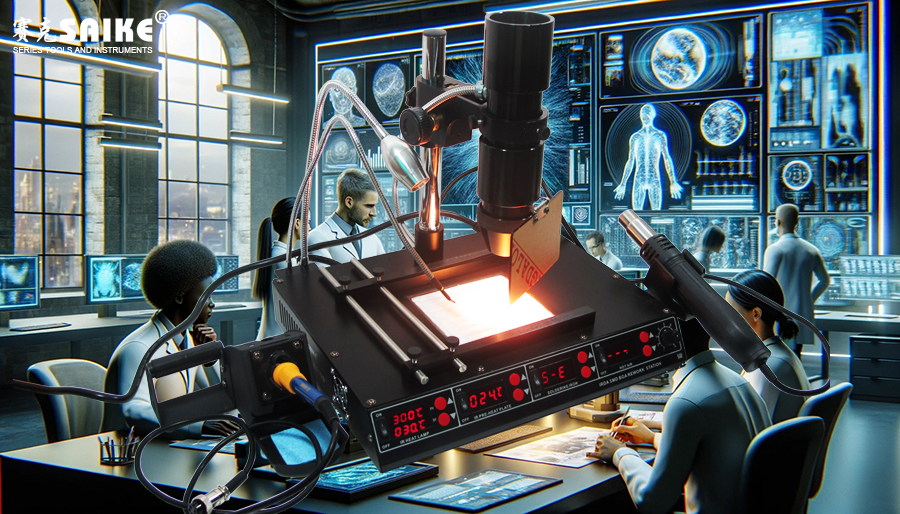
SK-YJ000HWXCHT-KP 100020
Infrared technology has found widespread applications in various fields such as industrial manufacturing, healthcare, security, and electronic maintenance, garnering significant attention due to its precise and non-contact nature. With the deepening of scientific research and technological development, infrared technology continues to make new progress, opening up more possibilities for future applications. This article provides a detailed introduction to the latest advancements in infrared technology and its potential future applications across different industries.
I. Latest Advances in Infrared Technology
1.Infrared Spectral Imaging:
– Hyperspectral Imaging: Using hyperspectral imaging technology, infrared can accurately identify and analyze different components on the surface or inside objects, which is widely used in food detection, medical diagnosis, and material analysis.
– Real-time High Resolution: New detectors and data processing algorithms have significantly improved the real-time resolution of infrared spectral imaging, enabling rapid target identification in dynamic situations.
2.High-Sensitivity Infrared Detection:
– Quantum Dot Detectors: Quantum dot-based infrared detectors maintain high sensitivity at low temperatures, making them suitable for astronomy and security monitoring.
– Multispectral Detection: New infrared detectors can simultaneously detect infrared light of different wavelengths, suitable for compositional analysis of different materials.
3.Infrared Heating and Control:
– Rapid Heating Systems: Infrared heating technology has developed more efficient emitters and reflector systems, significantly improving heating speed.
– Multi-Zone Heating Control: Through a multi-zone heating control system, temperatures in different areas can be independently controlled to meet diverse heating needs.
4.Infrared Communication:
– Free-Space Optical Communication: High-speed communication using infrared light in free space has been studied for applications in satellites, drones, and 5G communications.
– Near-Infrared Laser Communication: Near-infrared lasers are used for high-speed data transmission in communication fibers or data centers, potentially replacing traditional optical fiber communications.
II. Future Applications of Infrared Technology
1.Industrial Manufacturing:
– Infrared Inspection: Infrared technology can detect welding quality, surface defects, and material composition on industrial production lines to ensure production quality.
– Infrared Heating: In electronic manufacturing and metal processing, infrared heating systems enable precise heating, reducing thermal stress and improving production efficiency.
2.Medicine and Health:
– Infrared Thermal Imaging: This technology can monitor the temperature distribution of the human body, aiding in the early detection of health issues like infections and inflammation.
– Infrared Therapy: Non-contact heating through infrared rays can be used for physiotherapy on specific lesion sites, promoting blood circulation and tissue recovery.
3.Security Monitoring:
– Night Vision and Thermal Imaging: Infrared night vision devices and thermal imagers can clearly present targets at night or in bad weather, enhancing monitoring effectiveness.
– Intrusion Detection: Infrared detectors can monitor heat signals from intruders, useful for anti-theft and border surveillance.
4.Agriculture and Environment:
– Crop Monitoring: Infrared spectral imaging can monitor crop growth status and detect pests and diseases, improving the precision of agricultural production.
– Environmental Monitoring: Infrared can detect pollutants in the atmosphere and water, aiding in timely identification of pollution sources and environmental protection efforts.
5.Electronics and Communications:
– High-Speed Communication: Infrared offers high-speed and secure communication advantages, with potential for broader applications in 5G and quantum communications.
– Sensors and Positioning: Infrared sensors can be used for precise positioning, gesture recognition, and controlling smart devices, supporting the Internet of Things and smart homes.
III. Conclusion
Infrared technology has made significant progress in recent years, showing new trends in infrared spectral imaging, high-sensitivity detection, heating control, and communication. Its potential applications in industrial manufacturing, healthcare, security, agriculture, and communications will continue to expand, bringing more innovative possibilities to future smart manufacturing, health monitoring, and communication technologies. By fully utilizing the precision and non-contact nature of infrared technology, it will provide crucial support for high-quality development across multiple industries.


